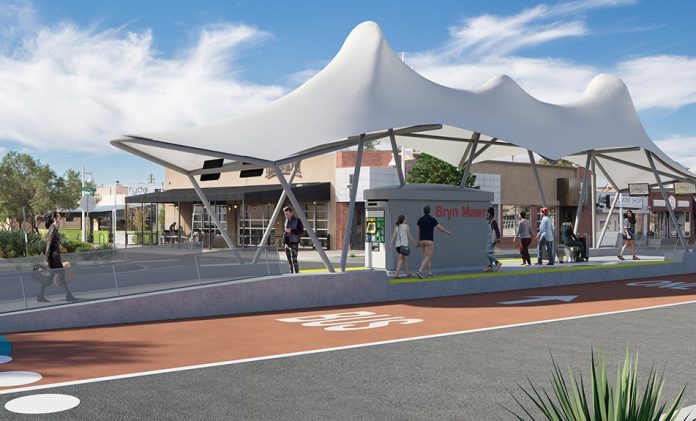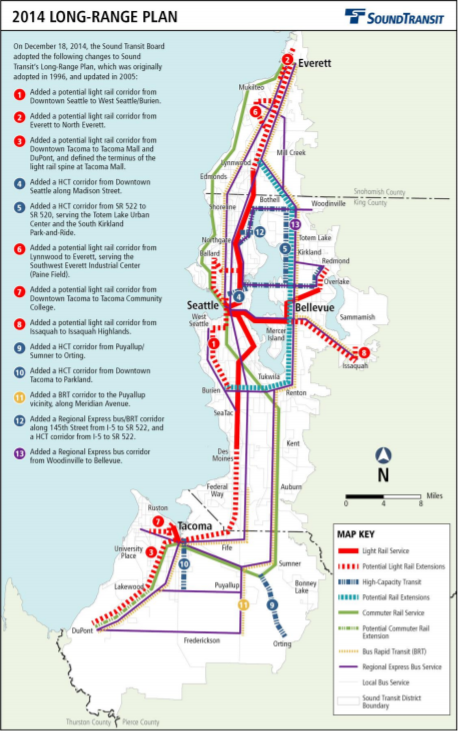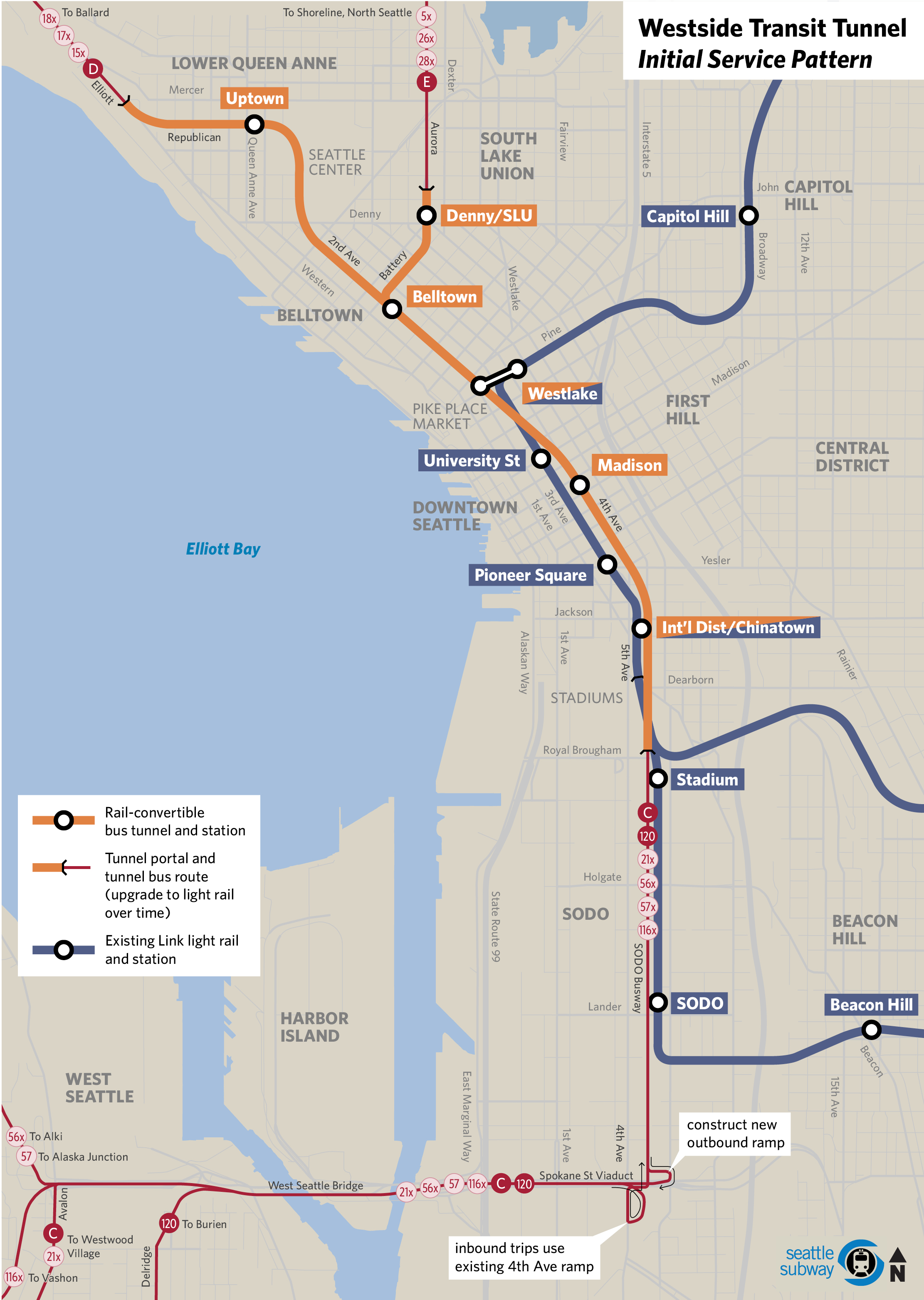
Author’s Note: This article is in response to Doug Trumm’s excellent piece on Aurora rail, which was in turn a response to Seattle Subway’s vision map. I recommend reading both, perhaps even first.
Is rail the right solution for Aurora Avenue?
When identifying future rail corridors, a logical place to start is high preforming bus lines, and King County Metro’s RapidRide E Line is a great place to start. Upgrading the Aurora corridor to rail would have many benefits, but I’m skeptical rail is what is best for this corridor. I see five major drawbacks in a bus-to-rail conversion.
- Cost. Even gold standard, fully grade-separated bus rapid transit (BRT) would be significantly cheaper than rail because Aurora is already limited access and partially grade-separated between Mercer Street and N 85th St, and there is adequate right-of-way for bus lanes. Most of the value of light rail construction comes from the creation of new right-of-way, and that simply isn’t necessary on this corridor.
- Local opposition. One of the reasons local politicians have consistently killed light rail along SR-99 in every subarea is residents and small business owners express serious concern about multiple years of construction on their doorstep. BRT can be implemented in a shorter timeframe and with less costly disruption.
- Stop diet. The E Line currently has 17 stops between Denny Way and N 145th St, while even the most optimistic rail line would have much less. Under Trumm’s rail proposal, the corridor would offer 10 stops. While studies show that people are willing to walk further for a subway station than for a bus station, I’d wager there would be no difference between bus and rail if they offered identical frequency and speed. The stop diet required for rail conversion means that we will need to continue to run local buses along Aurora to maintain the same quality of service for the community.
- Capacity overkill. Almost every long-term vision includes a Ballard-Lake City extension of light rail, which should adequately address any E Line peak capacity issues by providing an “interceptor.” Off-peak, the lack of high ridership would likely result in trains running less frequently than buses would in a BRT line.
- Missed interline opportunity. Rail misses the opportunity to interline E Line and Swift into a single BRT line, instead forcing a transfer somewhere between Seattle and Everett, wherever the rail happens to stop. Metro & CT’s route currently overlap in Edmonds, which not a logical transfer point. As the 3 county area continues to grow into a single urban amalgamation, we need a transportation network that reflects this unity. While E+SWIFT could be prohibitively long for a single driver, self-driving bus technology should eliminate this issue in the future.
Rail certainly has many benefits, and if cost was no concern, I would happily support another north-south subway. And a great advantage of a rail option is the ability to improve station location by deviating from the existing SR-99 alignment. Unless, of course, Ms. Frizzle is your bus driver.
A BRT solution for the region

My vision for Aurora BRT would be a line operated by Sound Transit that breaks down the arbitrary borders between Metro, Community Transit, and Everett Transit. The line would provide continuous service from Seattle to Everett, better connecting contiguous neighborhoods on SR-99. The service features for this line would be:
- Center-running but generally at-grade, leveraging the grade separation already built into Aurora Avenue between N 85th St and Mercer Street. Existing business access and transit (BAT) lanes would go away, so there is no impact on existing general purpose lanes. This design can make Aurora safer for all.
- Elevated stations at major intersections, allowing the buses to bypass traffic while building light rail-quality stations for pedestrian and bicycle access. For example, I’d imagine elevated stations at N 85th St, N 105th St, N 130th St, and N 145th St within Seattle.
- Existing RapidRide and Swift stop spacing would be used. Link light rail would remain the fastest option for “long haul” trips between Snohomish County and Seattle.
- A one-seat ride would be available for all neighborhoods between Seattle and Everett, absorbing the existing E Line and Swift Blue Line. Presumably, this would be funded and operated by Sound Transit, but it could be a joint operation between Metro and Community Transit as well.
I believe BRT fits the scale of SR-99. Look at the shape of growth corridors in Shoreline Town Center, Edmonds, and Seattle’s urban villages Aurora-Licton Springs and Bitter Lake. These are long, narrow stretches of density, better served by multiple bus stations than a single rail station. Unlike a freeway, development faces the street so a BRT station will not serve an ocean of asphalt. Nonetheless, there is ample existing right-of-way to repurpose for bus lanes, which makes a true BRT upgrade much easier, both technically and politically, than most of the other RapidRide+ corridors. Put another way, I am arguing the current SR-99 “stroad” is well suited for BRT.
A BRT solution for Seattle

In Seattle, any enhancements to bus infrastructure will also benefit Metro routes that use Aurora to get into downtown, such as Routes 5, 26, and 28. There are three options for serving downtown:
- At grade. This is the cheapest option but the most uninspiring. It likely doesn’t make sense to build excellent BRT north of the Ship Canal and then have buses get stuck in downtown traffic. There may be a way to do at-grade well, likely with a grade-separated crossing of Denny Way and then strong enforcement of a bus mall along 3rd Avenue.
- Elevated. Trumm sketches out what an elevated alignment would look like for a new line, and I think BRT would actually be superior to rail for this alignment because rubber tired buses would much more capable of handling the sharp turns and steep grades that this alignment would require. Additionally, First Hill can be seamlessly served as an elevated busway could transition directly into the Madison BRT bus lanes in First Hill.

- Tunnel. The last option is a new bus tunnel. A north-south tunnel quickly turns into Seattle Subway’s Westside Transit Tunnel concept–dating back to before the Sound Transit 3 package scope was widened–which means it could also serve others routes such as the Delridge RapidRide. Most other tunnel alignment options quickly run into issues with tunneling under the Ship Canal or I-5, and if we are going through the expense of tunneling under either of those, then we should probably just go ahead and build rail.
- Flying Bus. Actually, probably a bad idea.
AJ McGauley
AJ McGauley was a temporary transplant in the Seattle area, living in East King with his lovely wife for five years before returning to the great Midwest. Having lived in nine very different cities in the six years prior to moving to Washington, he discovered the wonky side of urbanism after reading The Urbanist and is interested in why cities grow (or don’t grow) in different ways. He worked for Sound Transit and can still be found riding transit for fun.
